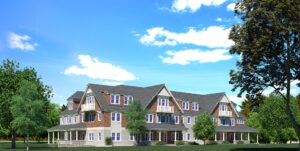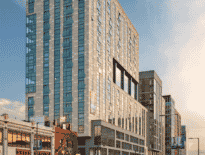
“Big House”-style multifamily developments that resemble large country estates are one design option for increasing housing production in Greater Boston. Image courtesy of Maguel Architects
Eric Bibb, a blues artist, wrote a song called “Shingle by Shingle” and sings “I’m fixing up the roof, shingle by shingle… got water in the well and I’m grateful.”
As Thanksgiving approaches, we can also be grateful that for most designers in New England, our pipelines are full, our own “water in the well.” But when it comes to the availability of high quality yet affordable housing, the well is nearly dry, and we can do better.
We are indeed facing a housing shortage, and some would argue that the mass production of large–scale, garden-style dwelling units in the suburbs will do the trick. These will help but, not so fast.
We live times when “fix it fast” thinking leads us far too often to design buildings fast, build them fast and sell them fast. Consider this column a red flag raised.
There are dizzying arrays of multi-family residential options being brought to the market, and we are all gambling and guessing on what type will be viable and appropriate for long-term stability of the regional housing market. The options range from 280-square-foot tiny homes in South Boston to 1,600-square-foot apartments in the suburbs. The question on everyone’s mind is: Which will succeed and why?
As buildable parcels decrease and construction costs increase, something has to give. Unfortunately, it’s the quality that is often sacrificed – the size of the units, the number of bedrooms and baths, and in many cases, thoughtful planning, design and construction.
Housing Designed Right, Not Fast
At Maugel, we work with many developers, builders and planners in the housing industry, each with their own vision, perspective and budgets.
Some believe that pre-manufactured accessory dwelling units (ADU) should be part of the mix. These are second residential units allowed by local zoning to be added to existing single-family home parcels for use by in-laws or even renters.
As buildable parcels decrease and construction costs increase, something has to give. Unfortunately, it’s the quality that is often sacrificed – size of the units, the number of bedrooms and baths, and in many cases, thoughtful planning, design and construction.
Others promote affordable housing in repurposed mill buildings, schools and even churches, usually incentivized with historic redevelopment tax credits. Even the “Big House” is back – multi-unit buildings that look like large estates. Another client is promoting housing towers in a suburban community.
Whatever the building type, we believe the real key to responsibly meeting our housing demands is quality; in its planning, its design and its construction.
One builder expressed his frustrations with rising construction costs of between 3 percent and 8 percent annually, and the extreme pressure to eliminate quality features that make great spaces, places and dwellings. He encouraged us as designers to seek new products, materials, building systems and design prototypes to diminish costs and elevate quality. Challenge accepted – and we must do better.
We Can Help
Those of us who are fortunate enough to work in the commercial real estate industry, especially in the architectural and engineering professions, have an incredible opportunity and powerful obligation to hold the line against quality erosion.

Brent Maugel
As a first step, we can work with local zoning officials to make significant improvements to ordinances that will plan for and incentivize the development of high-quality living communities in proximity to employment and amenity centers. Small dwellings that are big on style are trending upward when accessorized with smart spaces and local amenities.
These mixed-use communities in the suburbs will greatly reduce the need for long-distance commutes, easing the unbearably congested roadways. Five years ago, bumper-to-bumper traffic in the late afternoon west of Interstate 495 was unheard of. Today, in the search for cheaper housing, it is commonplace. With two-hour commutes from the western suburbs to and from Boston, something has to be done.
Let us also be motivated by a concern for the occupants of all housing types and care about their experience in the space. We need to take the time to design dignified, efficient, tech-smart, vibrant living environments for all economic sectors.
We should be advocates of developing housing right, not fast: designing housing exceptionally, not easily, and solving the housing crisis with quality, one step at a time, shingle by shingle.
And we will do better.
Brent Maugel is founder and president of Harvard-based Maugel Architects.




 |
| 
